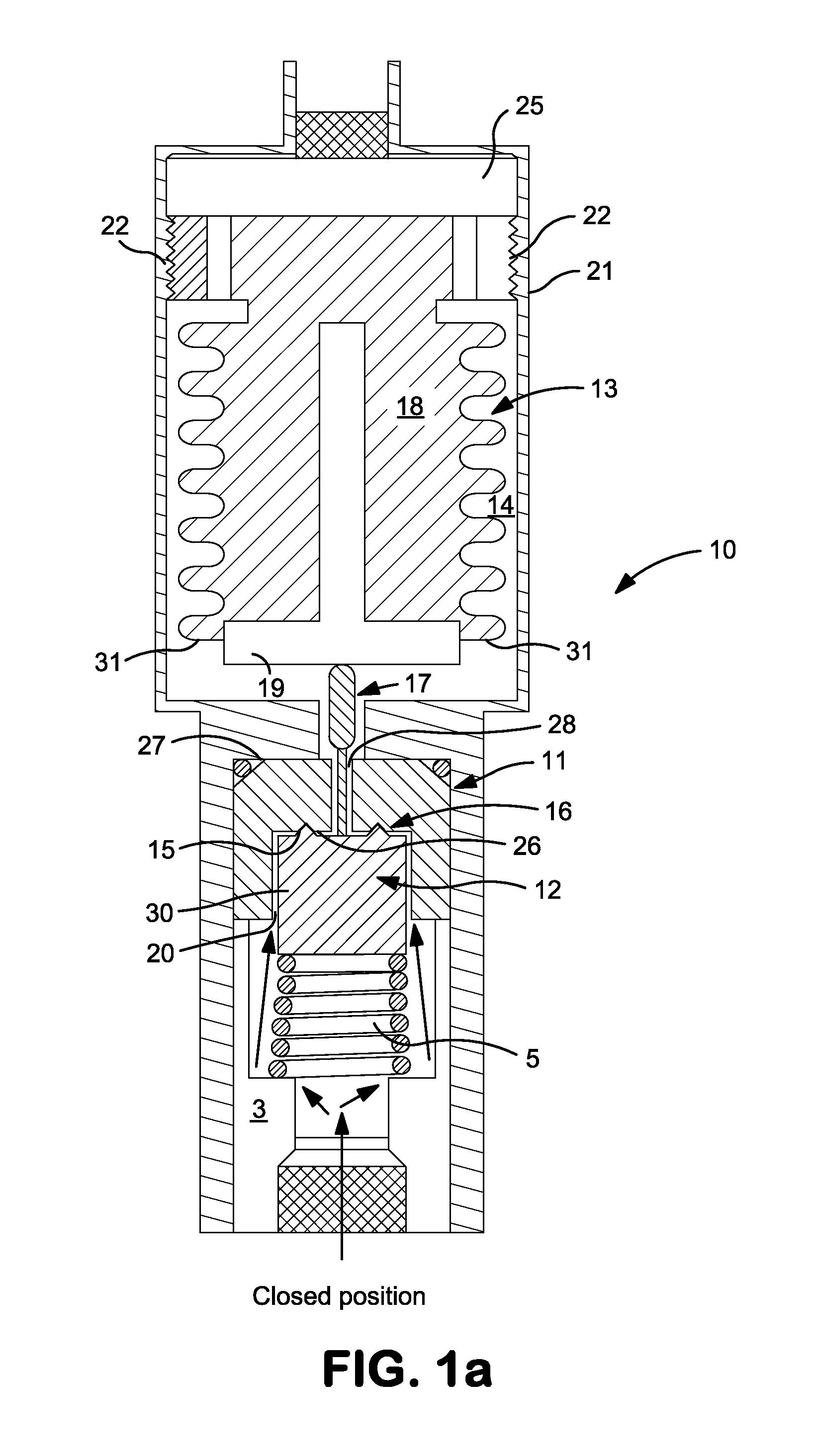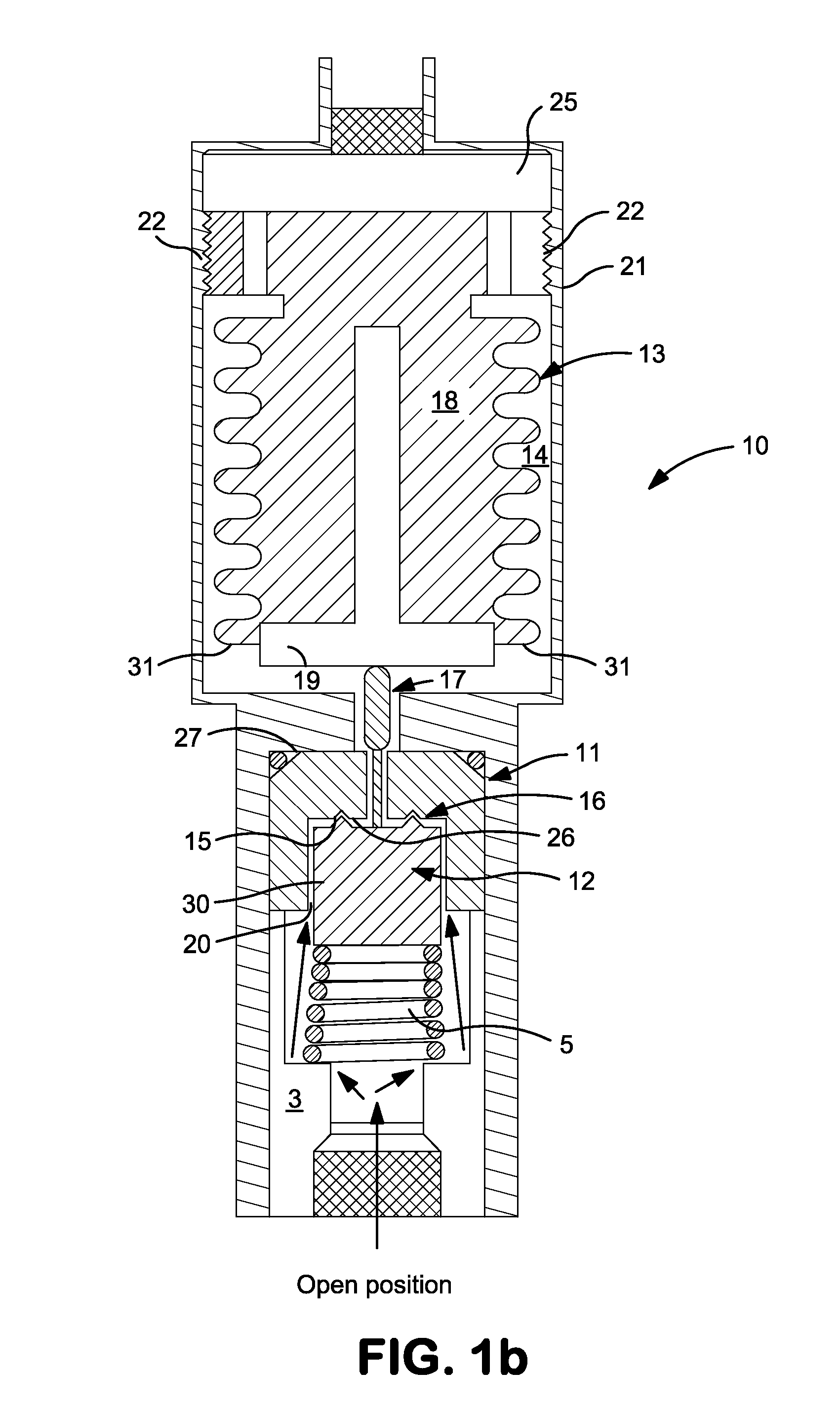Modified vacuum actuated valve assembly and sealing mechanism for improved flow stability for fluids sub-atmospherically dispensed from storage and delivery systems
- Summary
- Abstract
- Description
- Claims
- Application Information
AI Technical Summary
Benefits of technology
Problems solved by technology
Method used
Image
Examples
example 1
Modified Valve Assembly; 15% Xe—H2 at 1200 psig; FIG. 7 Test
[0088]The modified vacuum actuated valve assembly of the present invention, as shown in FIGS. 1a-1c, was inserted into a gas sub-atmospheric delivery and high pressure storage cylinder. A flow test was conducted to evaluate the valve opening behavior of the modified valve assembly. A gas mixture of 15% Xe and the balance hydrogen (Xe—H2) was filled into the cylinder so that the inlet pressure onto the valve assembly was 1200 psig. The cylinder was connected to a flow manifold that was configured identically as described in Comparative Examples 1 and 2. The flow test was performed under the same conditions as described in the Comparative Examples 1 and 2.
[0089]At approximately 50 seconds into the test, the modified valve assembly was actuated into the open position to dispense Xe—H2. FIG. 7 shows no delivery pressure spikes or oscillations occurred upon opening of the valve. As a result, the flow rate as measured by the mass...
example 2
Modified Design; BF3 at 1200 psig; FIG. 8 Test
[0091]The modified vacuum actuated valve assembly of the present invention, as shown in FIG. 1, was inserted into a gas sub-atmospheric delivery and high pressure storage cylinder. A flow test was conducted to evaluate the valve opening behavior of the modified valve assembly utilizing the same protocol as in Comparative Example 2. BF3 gas was filled into the cylinder so that the inlet pressure onto the valve assembly was 1200 psig. The cylinder was connected to a flow manifold that was configured as in Comparative Examples 1 and 2 and Example 1. The flow test was performed under the same conditions as Comparative Examples 1 and 2 and Example 1.
[0092]At approximately 50 seconds into the test, the modified valve assembly opened. FIG. 8 shows no delivery pressure spikes occurred upon opening of the valve. As a result, the flow rate as measured by the mass flow controller remained steady at its target value of 0.5 sccm. The modified valve e...
example 3
Modified Valve Assembly; 40,000 Cycles+13 Day BF3 Hold at 1280 psig; FIGS. 9A and 9B Test
[0095]The modified vacuum actuated valve assembly of the present invention was inserted into a gas sub-atmospheric delivery and high pressure storage cylinder, as shown in FIG. 1. The flow stability of the valve assembly was evaluated at a range of flow rates after subjecting the valve assembly to the same conditions as in Comparative Example 3, namely a series of various tests which totaled 40,000 cycles followed by a 13 day hold of BF3 at 1250 psig and 104° F. A single open and closing of the valve assembly designated a single cycle. Each cycle was performed using BF3 gas. The valve was opened and closed for 5000 cycles followed by conducting a run-down test that consisted of flowing BF3 at 4 sccm from the cylinder at a pressure of 1250 psi until the cylinder approached an empty condition. This protocol was repeated until a total of 40,000 cycles were completed. Next, flow tests were performed...
PUM
 Login to View More
Login to View More Abstract
Description
Claims
Application Information
 Login to View More
Login to View More - R&D
- Intellectual Property
- Life Sciences
- Materials
- Tech Scout
- Unparalleled Data Quality
- Higher Quality Content
- 60% Fewer Hallucinations
Browse by: Latest US Patents, China's latest patents, Technical Efficacy Thesaurus, Application Domain, Technology Topic, Popular Technical Reports.
© 2025 PatSnap. All rights reserved.Legal|Privacy policy|Modern Slavery Act Transparency Statement|Sitemap|About US| Contact US: help@patsnap.com



